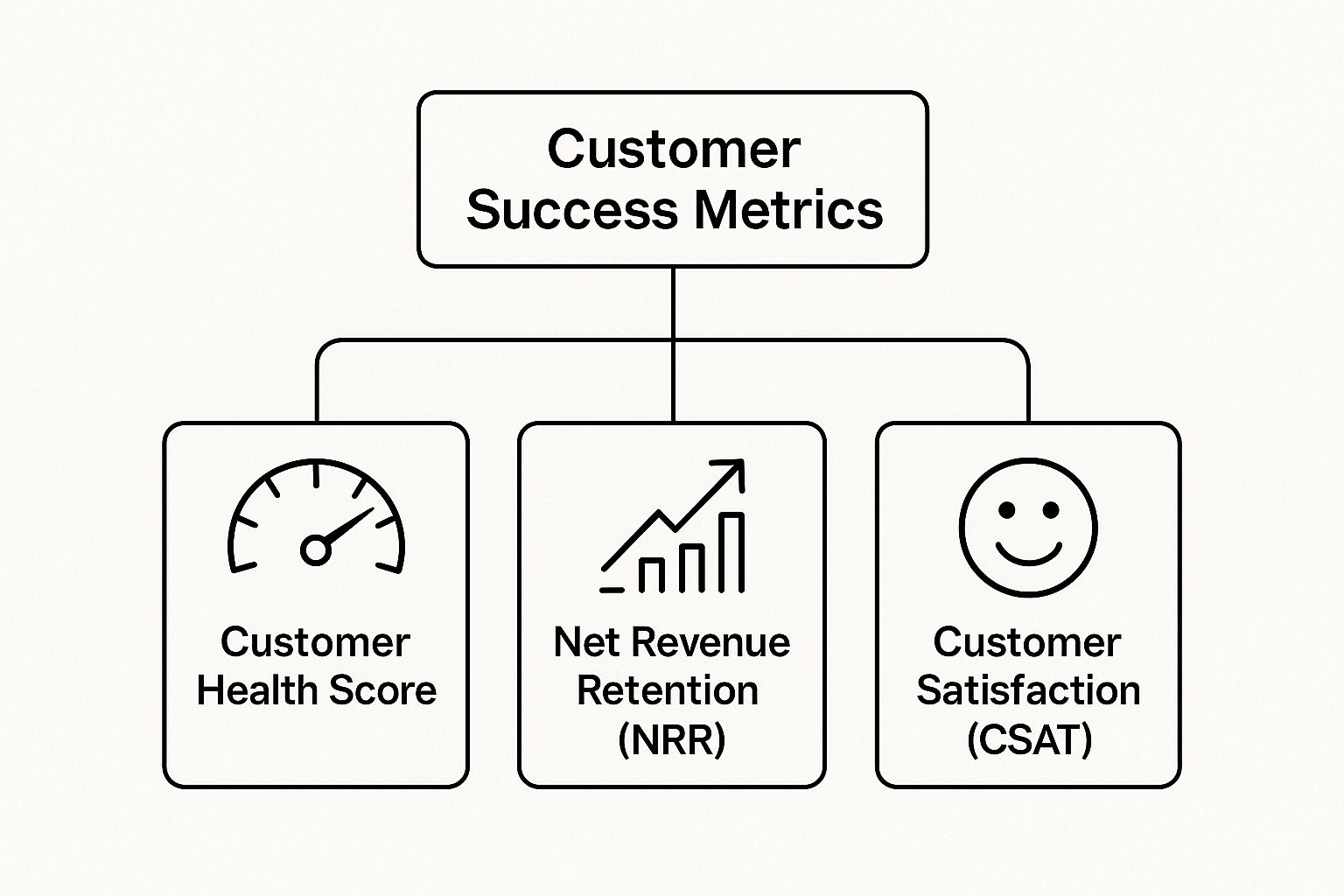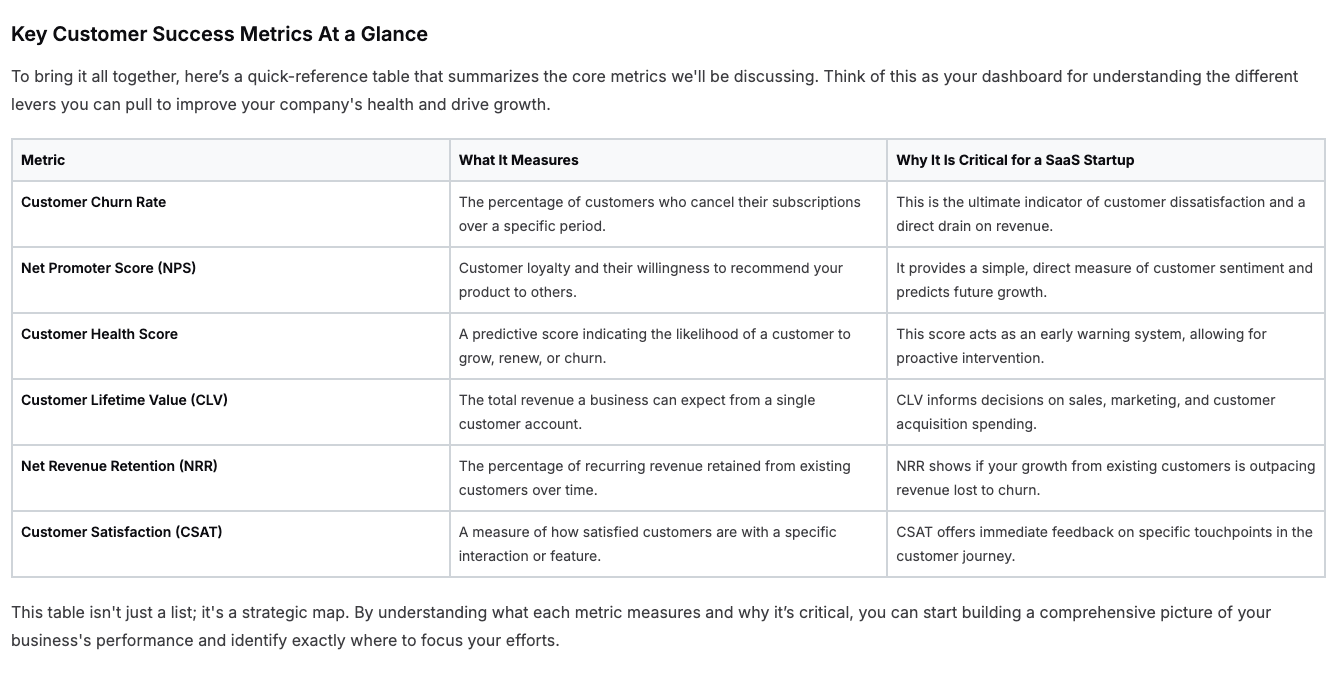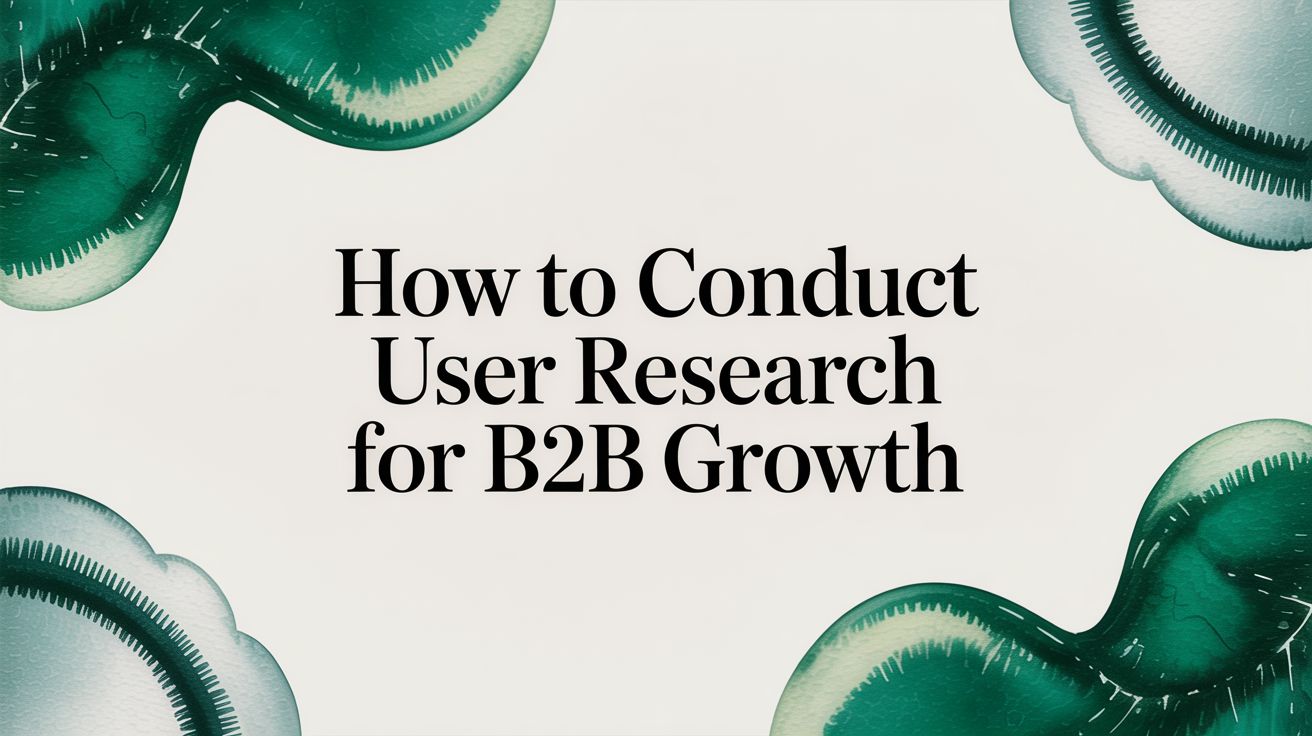Your Guide to Customer Success Metrics
July 23, 2025

When you hear the term “customer success metrics,” what comes to mind? For many, it’s a jumble of acronyms and charts. But in reality, they’re the vital signs of your business—the unfiltered truth about how healthy your customer relationships are and what your future revenue looks like.
They go beyond simple numbers to tell a story about customer satisfaction, loyalty, and the overall financial stability of your SaaS business.
Why Customer Success Metrics Are Your North Star
Ever tried captaining a ship without a compass? That's what running a SaaS startup without clear customer success metrics feels like. These numbers aren’t just for your CS team; they are the very heartbeat of your business, offering a real-time health check that empowers everyone, from product to sales, to make smarter, data-driven decisions.
Think of it this way: metrics are the language your customers use to tell you what they need, even when they aren't speaking to you directly. A sudden dip in a key metric is an early warning flare, signaling trouble on the horizon. An upward trend, on the other hand, confirms your strategies are hitting the mark.
Connecting Metrics to Growth
Ultimately, these indicators are the bedrock of sustainable growth. They provide the insights you need to build a truly customer-first culture, where every team member understands what a healthy customer relationship looks like. When that happens, the entire organization aligns around a single, powerful goal: delivering undeniable value.
"A business without customer success metrics is flying blind. These numbers provide the clarity needed to navigate market changes, predict revenue, and build a company that customers genuinely love."
This is more than just tracking individual data points. As the infographic below shows, top-level customer success goals break down into tangible metrics that cover everything from health scores and retention to overall satisfaction.

It’s clear that a holistic view requires you to track financial, satisfaction, and engagement indicators all at once. To really dig into what makes an essential KPI for Customer Success, you need to see how these different pieces fit together.
The Critical Role of Churn
Speaking of vital signs, customer churn rate is one of the most important. For most SaaS companies, an average monthly churn rate falls somewhere between 5% to 7%. The best-in-class companies, however, manage to keep it below 5%.
Why the obsession with churn? Because reducing it has an outsized impact on your bottom line. Even a 1% decrease in churn can boost your company's valuation by 10% or more, thanks to the compounding effect of keeping customers around longer and increasing their lifetime value.
Key Customer Success Metrics At a Glance
To bring it all together, here’s a quick-reference table that summarizes the core metrics we'll be discussing. Think of this as your dashboard for understanding the different levers you can pull to improve your company's health and drive growth.

This table isn't just a list; it's a strategic map. By understanding what each metric measures and why it’s critical, you can start building a comprehensive picture of your business's performance and identify exactly where to focus your efforts.
Using Net Promoter Score To Measure Loyalty

While some metrics give you a snapshot of satisfaction with a single interaction, the Net Promoter Score (NPS) paints a much bigger picture. It’s your window into overall customer loyalty and one of the most powerful predictors of organic growth.
The whole system hinges on one deceptively simple question: "On a scale of 0-10, how likely are you to recommend our company/product/service to a friend or colleague?"
Based on their answer, you can sort every customer into one of three buckets.
Understanding Your Customer Groups
Figuring out which customers go into which bucket is the first step to turning this raw feedback into a genuine growth engine. Each group tells you something different about your business and where you need to focus your energy.
- Promoters (Score 9-10): These are your champions. They aren't just satisfied; they're genuinely enthusiastic fans who will actively tell others about you, driving word-of-mouth referrals and organic growth.
- Passives (Score 7-8): These customers are content, but they're not raving fans. They got what they paid for, but they aren't going out of their way to sing your praises. This group is also the most vulnerable to a better offer from a competitor.
- Detractors (Score 0-6): These are your unhappy customers. They're dissatisfied and at a high risk of churning. Worse, they can actively damage your brand's reputation with negative reviews and poor word-of-mouth.
How To Calculate Your NPS
The math behind NPS is refreshingly simple. You just subtract the percentage of Detractors from the percentage of Promoters. Passives get counted in your total number of responses, but their scores don't directly factor into the final calculation.
NPS = % Promoters - % Detractors
Let’s run a quick example. Say you survey 100 customers. You find that 60 are Promoters (60%), 25 are Passives (25%), and 15 are Detractors (15%).
Your NPS would be 45 (which is 60 - 15).
For a B2B SaaS company, any positive score is a good start. Anything over 50 is generally considered excellent.
But the real power of NPS isn’t the number itself—it's what you do with it. Following up with Detractors to understand and resolve their issues can turn them into Passives or even Promoters. Mobilizing your Promoters with a referral program can be more effective than many traditional marketing campaigns. For B2B SaaS startups, leveraging these advocates is one of many core B2B sales tactics that can really accelerate growth.
To get the most out of your surveys, it helps to see how others are doing it. You can explore some powerful NPS question examples that go beyond the standard query. This can help you gather more specific, actionable insights to improve your score and, more importantly, your customer relationships.
Capturing In-The-Moment Customer Sentiment
While Net Promoter Score (NPS) gives you the big-picture view on loyalty, the Customer Satisfaction Score (CSAT) is your tactical, in-the-moment pulse check. Think of it as a microscope. It zooms in to answer one incredibly important question: "Did we get this specific interaction right?"
CSAT is all about immediacy. You’re typically asking a simple, direct question like, “How satisfied were you with this interaction?” paired with a straightforward rating scale (like 1 to 5). You're not asking about their overall feelings toward your brand; you're isolating a single, recent experience to get raw, unfiltered feedback right when it happens.
This kind of targeted insight is priceless for finding out exactly where your customer experience is either shining or stumbling.
Finding the Right Moments for Feedback
The real magic of CSAT comes from using it at the right time. You need to deploy it at the most critical touch-points in the customer journey—those moments of truth where a customer’s perception is actively being shaped. By zeroing in on these key interactions, you can collect hyper-specific feedback that leads to real improvements.
If you need a hand identifying these pivotal stages, our guide on B2B customer journey mapping is a great place to start.
Here are a few perfect moments to send a CSAT survey:
- Immediately after a support ticket is resolved: This is a direct measure of your support team’s effectiveness.
- Following a new feature onboarding: Did the training actually help the user feel confident and empowered?
- After a major purchase or upgrade: This helps you gauge satisfaction with the entire sales and implementation experience.
- When a user completes a key task in your software: Were they able to achieve their goal with ease, or was it a struggle?
Calculating and Benchmarking Your CSAT
Figuring out your CSAT score is refreshingly simple. The most common approach is to focus on the positive. First, you decide what counts as a "satisfied" response—on a 5-point scale, that’s usually a 4 or a 5.
Then, you just plug your numbers into this formula:
CSAT (%) = (Number of Satisfied Responses / Total Number of Responses) x 100
This gives you a clear percentage of customers who walked away from that interaction feeling good. But what’s a "good" score, really?
Globally, CSAT scores for SaaS companies tend to hover between 70% and 85%. And the pressure is on—by 2025, it’s predicted that over 75% of organizations will rely on CSAT as a core measure of customer success. World-class companies consistently aim for scores above 80%. You can dig into more customer success benchmarks over at Brand24.com.
Don't mistake high CSAT scores for a simple vanity metric. They are a powerful leading indicator of customer loyalty and reduced churn. Every positive interaction is another brick in the foundation of a strong customer relationship, making them more likely to stick around, expand their use of your product, and eventually become your biggest fans.
The Financial Metrics That Define Success

While loyalty and satisfaction scores give you a window into how your customers feel, financial metrics tell you the unfiltered truth about how your company is doing. If your customers are the heart of your SaaS business, then your Monthly Recurring Revenue (MRR) and churn are its pulse and blood pressure. These numbers define your stability, your potential to scale, and ultimately, your shot at long-term success.
Think of MRR as the predictable, rhythmic beat of income that keeps your business running month after month. It's the very foundation you build all your growth upon. But that foundation can develop serious cracks if you aren't paying close attention to churn—the rate at which you lose customers and revenue.
Here’s where it gets interesting, though. Not all churn is created equal. In fact, understanding the difference between losing a customer and losing the revenue they represent is one of the most critical distinctions a SaaS founder can make.
Distinguishing Customer Churn from Revenue Churn
It’s tempting to treat every lost customer as the same, but the financial hit can vary wildly. This is where you have to look beyond just one number.
- Customer Churn: This is a simple headcount. It’s the percentage of customers who cancel their subscriptions in a given period. For example, if you lose 5 out of 100 customers in a month, your customer churn rate is 5%.
- Revenue Churn: This measures the percentage of monthly recurring revenue you lost from those same canceling customers. It answers the real question: "How much money actually walked out the door?"
Let’s say two customers cancel this month. Customer A was paying $50/month, while Customer B was paying $500/month. Your customer churn is two, a seemingly small number. But your revenue churn tells a far more dramatic and important story. Focusing only on the headcount can hide a serious financial leak that’s sinking your ship.
Uncovering the Full Story with Net MRR Churn
To get a truly complete picture of your financial momentum, you need to go one step further and calculate Net MRR Churn. This is where the magic really happens for a healthy SaaS business. Net MRR Churn doesn't just account for the revenue you lose; it also factors in the new revenue you gain from your existing customers.
Net MRR Churn reveals the true health of your customer base by balancing lost revenue from churned customers against the expansion revenue generated by your happy, growing customers.
This is calculated by taking your revenue churn and subtracting any Expansion MRR—the additional monthly recurring revenue from upgrades, cross-sells, or add-ons from your current customers.
Let's break this down with a simple example:
- Lost MRR: You lose $5,000 from customers who canceled this month.
- Expansion MRR: But, your existing customers upgraded their plans, adding $3,000 in new MRR.
- Net MRR Churn: $5,000 (Lost) - $3,000 (Expansion) = $2,000.
Your net churn is $2,000. The ultimate goal for any B2B SaaS is to achieve negative net churn, where your expansion revenue is greater than the revenue you lose from cancellations. This means your business is growing even without acquiring a single new customer—a powerful sign of a sustainable, healthy business model.
By mastering these financial customer success metrics, you're not just tracking numbers. You're building a revenue engine designed for acceleration, not just survival.
Building a Business That Lasts with LTV and CAC
While metrics like churn and MRR give you a snapshot of your company's health right now, two other metrics tell the story of your future: Customer Lifetime Value (LTV) and Customer Acquisition Cost (CAC). When you look at these two together, you can answer the most important question any B2B SaaS founder has: "Is my business model actually built to last?"
Think of it like building an engine. You absolutely need to know how much fuel it takes to get started (that's your CAC) and how far you can actually drive on that tank of fuel (that's your LTV). If it costs you more to get the engine running than the distance you can travel, your journey is over before it even begins.
The Lifetime Value of a Customer
Customer Lifetime Value (LTV), which you'll also see called CLV, is a projection of the total revenue you can reasonably expect to earn from a single customer over the entire time they're with you. It’s not just about their first payment or their first year; it's a forecast of their total worth to your business.
A high LTV is a fantastic signal. It tells you that your customers are happy, they're sticking around, and they're consistently finding value in what you offer.
Calculating a perfect LTV can get complicated, but a straightforward formula for SaaS startups is:
LTV = (Average Revenue Per Account / Customer Churn Rate)
This simple equation makes it crystal clear: the longer you keep a customer (meaning, the lower your churn), the more valuable they become over time.
The Cost to Acquire a Customer
On the flip side of the coin, you have the Customer Acquisition Cost (CAC). This metric sums up all of your sales and marketing expenses over a set period and divides that total by the number of new customers you signed up in that same timeframe. For a much deeper look, check out our complete guide on how to calculate customer acquisition cost.
Your CAC isn't just your ad spend. It includes everything from content creation and sales team salaries to your marketing software subscriptions. It’s the total investment you make to win a new logo.
The real magic doesn't come from looking at LTV or CAC by themselves. The most crucial insight comes from comparing them. The LTV to CAC ratio reveals the true profitability of your business model and your potential for long-term growth.
For any SaaS business to be healthy and sustainable, your LTV needs to be significantly higher than your CAC. A widely accepted benchmark to aim for is an LTV:CAC ratio of 3:1 or higher. This means for every dollar you spend to get a customer, you can expect to get at least three dollars back over their lifetime.
Let's break that down:
- A ratio below 1:1 is a red alert. You're actively losing money on every new customer you sign.
- A ratio of 1:1 means you're just breaking even. You're essentially spending a dollar to make a dollar.
- A ratio of 3:1 or higher signals a strong, profitable, and scalable business model. This is the kind of number that gets investors excited.
Improving this golden ratio is at the very heart of any customer success strategy. You can pull two levers: either increase LTV (by reducing churn and encouraging upgrades) or decrease CAC (by optimizing your marketing spend and improving conversion rates). When you master this balance, you’re not just tracking numbers—you’re engineering a business built for enduring success.
Putting Your Customer Success Metrics Into Action

Alright, you’ve done the hard work of tracking and calculating your customer success metrics. Now what? Data is just noise until you give it a purpose. The real magic happens when you use these numbers to drive meaningful action, shifting your team from reactive problem-solving to proactive relationship-building.
Your first move is to stop looking at these metrics as isolated numbers on a spreadsheet. Instead, see them as chapters in your customer's story. The best way to read that story is through a centralized customer success dashboard—an at-a-glance health check for your entire customer base. This isn’t just another report; it’s your command center for making smarter decisions.
Build a Metric-Driven Culture
With a clear dashboard in place, you can finally move from just observing to actually operating. The goal is to build a culture where data is the starting point for every single conversation about the customer.
Start by setting realistic, metric-based goals for your team. A vague goal like "improve satisfaction" doesn't give anyone a clear target. Instead, aim for something tangible: "Let's increase our CSAT score from 75% to 82% this quarter." This gives your team a finish line to race toward. It also creates a direct link between their day-to-day efforts and the company's bottom line, a crucial connection when you consider how to measure marketing success in a data-driven world.
Turning insight into impact is the final, most crucial step. Use your metrics to set up automated triggers for proactive outreach, celebrate wins when the numbers trend up, and embed customer data into every decision, from product roadmaps to marketing campaigns.
Finally, let your metrics guide your team’s actions. A dip in a customer’s health score shouldn't just be an observation—it should be an automated trigger for a CSM to reach out. When you see your Net Revenue Retention (NRR) tick upward, don't just note it in a report; celebrate that win with the entire company.
This is how you bring your data to life. You build a system where every number tells your team where to focus, ensuring the customer is at the center of every single decision. This proactive, data-informed approach is what separates the SaaS companies that merely survive from the ones that truly thrive.
Frequently Asked Questions
You've got questions, we've got answers. Here's a quick rundown of some common queries we hear from B2B SaaS founders trying to get a handle on their customer success metrics.
Which Metric Should An Early-Stage Startup Focus On First?
If you're an early-stage SaaS startup and can only track one thing, make it Net Revenue Churn.
While it’s tempting to obsess over how many customers you lose (logo churn), net revenue churn gives you the full financial picture. It balances the revenue you lose from departing customers against the new revenue you gain from your existing ones through upgrades and expansion.
A low or even negative net revenue churn is one of the most powerful signs you've found product-market fit and are building a business that can actually last.
How Often Should We Review Our Customer Success Metrics?
The right cadence depends on the metric.
Leading indicators, like Customer Satisfaction (CSAT), need to be monitored in real-time. This is your immediate feedback loop. For lagging indicators like churn and Customer Lifetime Value (LTV), a monthly and quarterly review cycle works best.
Monthly check-ins help you catch trends and put out small fires before they become big problems. Quarterly reviews are where you zoom out and make bigger, more strategic decisions.
The key is consistency. A regular review cadence turns data into a predictable tool for growth, preventing small issues from becoming major problems down the line.
What Are The Best Tools For Tracking These Metrics?
Honestly, you can get surprisingly far with a good old-fashioned spreadsheet in the very beginning. But as you grow, that will break.
Once you start to scale, dedicated Customer Success Platforms like Gainsight, ChurnZero, or Catalyst become non-negotiable. These tools are the real deal—they plug into your CRM and product analytics to automate all the number crunching, give you live customer health scores, and even send proactive alerts.
Getting that data integrated and working together is crucial. It’s a lot like making sure your marketing content and sales goals are in sync, which is something we talk about in these B2B content examples for sales enablement.
At Big Moves Marketing, we specialize in helping B2B SaaS startups build the strategic foundation for this kind of data-driven growth. If you need help turning your metrics into a clear go-to-market strategy, visit us at https://bigmoves.marketing.
%20-%20Alternate.svg)


%20-%20white.svg)